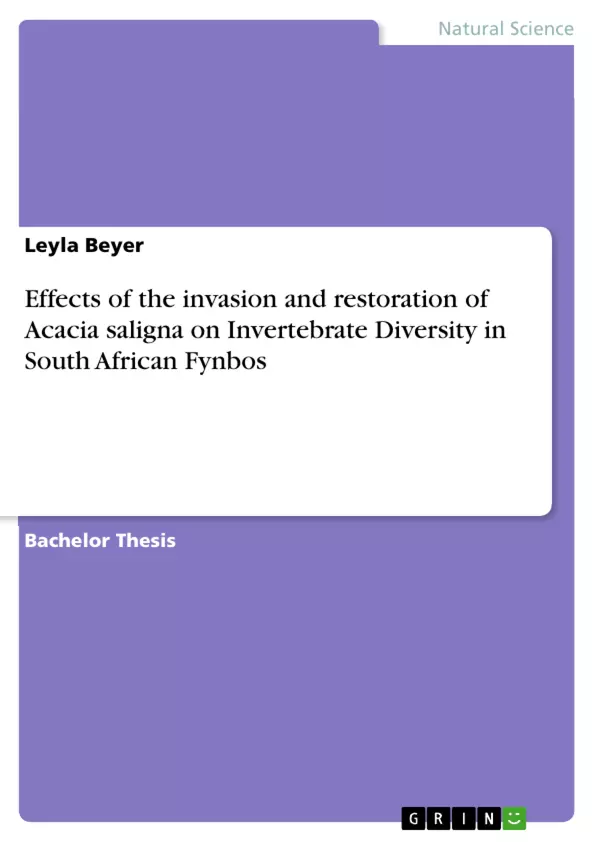The invasive plant Acacia saligna (Labill.) Wendl., from here on referred to only as ‘Acacia’, is widespread in the Cape Floristic Region, a global biodiversity hotspot in South Africa, with stark impacts on diversity. The goal of this study was to obtain a comprehensive estimation of the effect of the invasive alien plant Acacia saligna and its clearing on invertebrate diversity in Cape Flat Sand Fynbos. In three selected areas of the region, invertebrates were collected with pitfall traps and their diversity compared among uninvaded reference sites, cleared sites, and Acacia-invaded sites.
Most past studies focus on the plant response to the invasion of Acacia saligna. Conversely, this thesis aims to fill the gaps in knowledge by focusing specifically on the impacts of the Acacia invasion and clearing on invertebrates in Cape Flat Sand Fynbos. To understand the influences on invertebrates this study investigated the variation in invertebrate diversity and composition among Acacia saligna invaded sites, and subsequently cleared sites, in comparison with uninvaded Fynbos sites. My objectives were to:
(1) Identify the diversity of the invertebrate orders in the areas selected
(2) and to assess how the invertebrate diversity in Fynbos is influenced by the invasion and
clearing of the Acacia;
(3) Analyze similarities and differences in invertebrate composition among the different sampling sites and status;
(4) Analyze if a selection of the orders sampled individually respond differently to the invasion and clearing of Acacia in contrast to the overall invertebrate response;
(5) Investigate correlations between the invertebrate diversity and plant diversity response to the invasion of Acacia.
Inhaltsverzeichnis (Table of Contents)
- Abstract
- Abbreviations
- Introduction
- Material and Methods
- Study Site and Site Selection
- Data Collection
- Data Analysis
- Results
- Discussion
- Conclusion and Prospects
- Bibliography
- Appendix
Zielsetzung und Themenschwerpunkte (Objectives and Key Themes)
This study aims to comprehensively assess the effects of the invasive alien plant Acacia saligna and its removal on invertebrate diversity in Cape Flat Sand Fynbos, a unique biodiversity hotspot in South Africa. The study investigates the impact of Acacia invasion on invertebrate richness, community composition, and diversity indices in three selected areas of the region.
- Impact of invasive alien plant Acacia saligna on invertebrate diversity in Cape Flat Sand Fynbos
- Comparison of invertebrate diversity in uninvaded reference sites, cleared sites, and Acacia-invaded sites
- Analysis of the recovery of invertebrate diversity after clearing of Acacia
- Investigating the correlation between invertebrate diversity and plant diversity, and Acacia cover
- Understanding the ecological impacts of Acacia invasion on the Fynbos ecosystem
Zusammenfassung der Kapitel (Chapter Summaries)
- Introduction: This chapter presents a comprehensive overview of the Cape Floristic Region (CFR) and its significance as a global biodiversity hotspot. It highlights the unique biodiversity and high endemism of the Fynbos biome, focusing on the potential role of invertebrates in this ecosystem. The chapter discusses the challenges posed by invasive alien plants, particularly Acacia saligna, and their impact on the Fynbos ecosystem.
- Material and Methods: This chapter describes the study site, site selection, and data collection methods used in the study. It outlines the sampling techniques employed for collecting invertebrates, including pitfall traps, and the subsequent analysis of the collected data. This section details the statistical analyses used to assess the impact of Acacia invasion and clearing on invertebrate diversity.
- Results: This chapter presents the findings of the study, analyzing the invertebrate richness, community composition, and diversity indices. The data analysis highlights the differences in invertebrate diversity observed between uninvaded reference sites, cleared sites, and Acacia-invaded sites.
- Discussion: This chapter interprets the results of the study, exploring the ecological implications of Acacia invasion and its clearing on invertebrate diversity in the Fynbos ecosystem. The discussion examines the observed shifts in invertebrate community composition, richness, and diversity indices, and explores the potential mechanisms underlying these changes.
Schlüsselwörter (Keywords)
The study focuses on the ecological impact of the invasive alien plant Acacia saligna on invertebrate diversity in the Cape Flat Sand Fynbos, a global biodiversity hotspot in South Africa. The research explores the relationships between invertebrate richness, community composition, and diversity indices in relation to the invasion and restoration of this alien plant. Key themes include the impact of invasive species, biodiversity conservation, ecosystem restoration, and the role of invertebrates in ecosystem functioning.
- Arbeit zitieren
- Leyla Beyer (Autor:in), 2021, Effects of the invasion and restoration of Acacia saligna on Invertebrate Diversity in South African Fynbos, München, GRIN Verlag, https://www.grin.com/document/1319088



